
The recent events in Belarus are a perfect example. It's not a color revolution, but President Alexander Lukashenko "repeating Soviet mistakes," argues Bradley Blankenship. While he is looking at the behavior of the protesters on the ground, however, Caitlin Johnstone is looking at the State Department. Foggy Bottom's actions and "imperial narrative management" by official US propaganda outlets have her convinced it is a color revolution. She's not the only one.
That's precisely the problem, however: in a world where "color revolutions" have become normalized, it's nearly impossible to tell if a mass protest is a spontaneous, grassroots event or an astroturfed regime-change operation. To the creators of color revolutions, this is a feature, not a bug.
The tactic has been around for two decades now, first tested following the September 2000 elections in Serbia. It involves activists trained by US-backed "NGOs," copious amounts of cash, strategies and tactics outlined in a manual written by the late Gene Sharp. The key element is narrative management, through which the revolutionaries usurp the initial protests and direct them towards their own ends.
One distinguishing feature of astroturf campaigns is a visual marketing campaign, such as the stenciled fists of Otpor in Serbia (used elsewhere since), or the 2004 orange scarves and banners in Ukraine. The sudden omnipresence of white-red-white flags in Belarus - used briefly in 1918 and again under Nazi occupation - seems to fit this pattern. So do the signs like "Belarusian Lives Matter," appealing not to the locals but to the West.
Back in the early days of the manufactured coups, when the US was drunk on their success, Western media actually openly admitted Washington's hand in these "spontaneous" uprisings. Stories about "suitcases full of cash" that fueled the revolt in Serbia appeared shortly after the coup in Belgrade. In November 2004, the Guardian wrote approvingly about how the US has created a "slick" operation of "engineering democracy through the ballot box and civil disobedience," developing since Belgrade a "template for winning other people's elections."
These days, there is no boasting, but the practice continues nonetheless. Most recently, the scenario played itself out in Bolivia (successfully), Venezuela (not) and Hong Kong, where "pro-democracy" protests against an extradition bill lasted long after it was withdrawn.
What changed is that the US and its media machine switched to denying involvement and pretending the "color revolutions" were actually genuine expressions of democracy, after some targeted governments managed to defeat these astroturf rebellions. This remained the case even as color revolution tactics came home to the US this summer.
Back in June, Franklin Foer of the Atlantic magazine - a megaphone of the establishment - actually wrote a favorable comparison of the riots across the US, posing as peaceful protests for "racial justice," to the color revolutions in places like Ukraine and Serbia. Note that Foer believes these revolutions were good and genuine things, rather than a hostile takeover tactic that was basically a mockery of democracy.
Democracy, at its essence, it's a straightforward deal. Citizens vote on an issue or for a candidate, and agree to abide by the rules whether they win or lose. But what happens when that vote is manipulated - through street violence, in this case - by outsiders, and the rulebook gets thrown out the window?
This is what makes color revolutions not just wrong, but evil. They literally destroy democracy, by corroding the very rules it is founded on. When they fail, things can escalate along the lines of Libya, Syria or Ukraine.
Even when they fail peacefully, like the 2006 "jeans revolution" in Belarus, they poison a country's politics so thoroughly, that the government sees any street demonstrations going forward as foreign-sponsored coup attempts. Especially when foreign powers openly express support for it, as has been the case with recent events.
Comment: And the people hurt most, as always, are the regular people, who, as Malic points out in the first paragraph, have their legitimate grievances either ignored by the ruling party, or exploited by foreign powers who "just want to help."
Whatever may be happening in Belarus right now, democracy it is not. The US may not be one for long, either, if things carry on as they have. Two decades of color revolutions have made sure of that.
Nebojsa Malic is a Serbian-American journalist, blogger and translator, who wrote a regular column for Antiwar.com from 2000 to 2015, and is now senior writer at RT. Follow him on Twitter @NebojsaMalic



Reader Comments
to our Newsletter